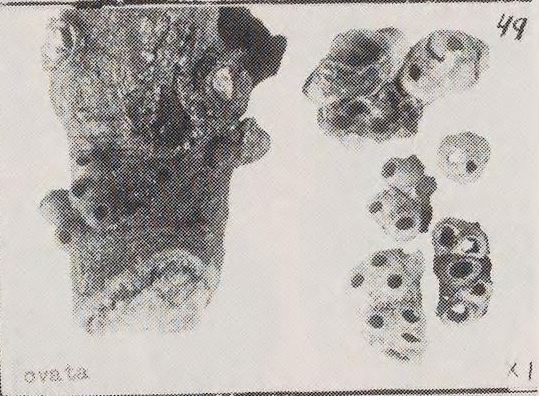Callirhytis ovata (agamic)
Callirhytis ovata, new species
Host. — Quercus catesbaei Michaux, Quercus myrtifolia Willdenow, Quercus texana Buckley.
Gall. — Cells in and protruding from the brown bark at crown of small trees, 5 to 10 cm. underground. When single, they are elliptical in outline, sessile, 6 mm. high by 5 mm. in diameter, light brown in color and smoother than the surrounding bark. Exit hole 2.6 mm. in diameter at distal end. They are sometimes detachable. They often occur in rows or in groups of a dozen or more. When confluent, a local swelling of the bark is produced, but the number of cells contained is evident. The figure shows galls on Q. myrtifolia. On Q. catesbaei they usually occur on larger roots at least 2 to 5 cm. in diameter and often in the angles where branch roots arise.
Habitat. — The type galls were collected at Marianna, Florida, October 11, 1919, on Q. catesbaei and then contained pupae. Living flies were cut out of the galls on December 3. More were taken at Ocala October 30, and these also contained pupae. Galls found at Ocala April 15, 1914, were empty. These galls were also found at Madison and Jacksonville. The species transforms inside the galls in November and probably emerges in early spring. The fact that some galls still contained larvae in December when others in the same groups contained adults suggests that the emergence is distributed over two years. Similar galls were collected on Q. myrtifolia at Daytona, Florida, on November 20, 1919. Some pupae had already trans- formed into adults and a few were still in pupa state when flies were cut out on November 28 and December 3. At Boerne, Texas, October 26, 1917, old galls were seen on Q. texana as well as full-grown fresh ones, some of which contained a thick nutritive layer and others pupae or adults.
”- LH Weld: (1921) American gallflies of the family Cynipidae producing subterranean galls on oak©
Reference: https://www.biodiversitylibrary.org/page/7562993#page/276/mode/1up







